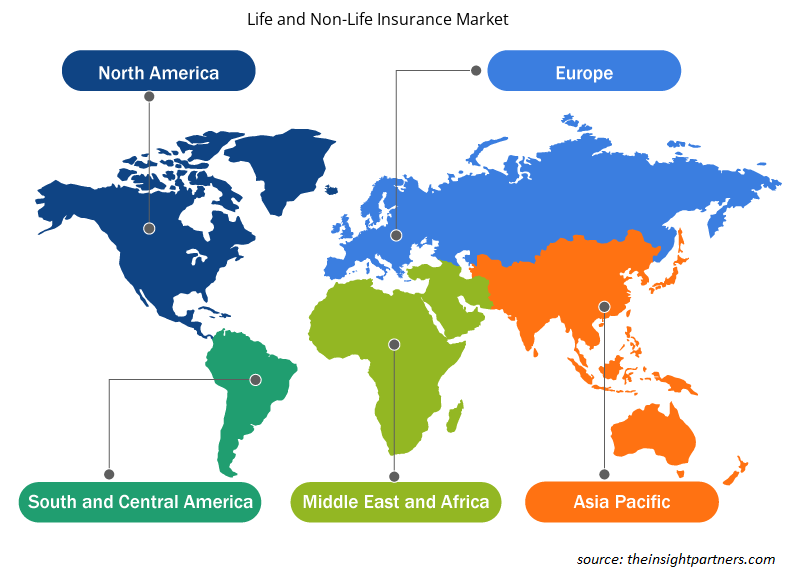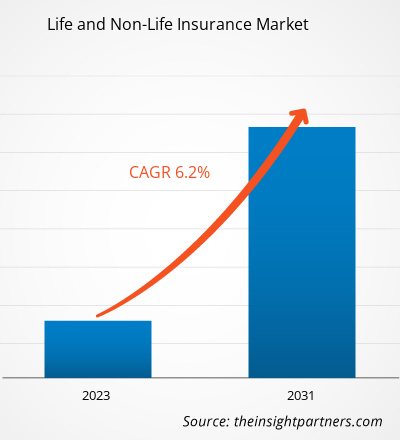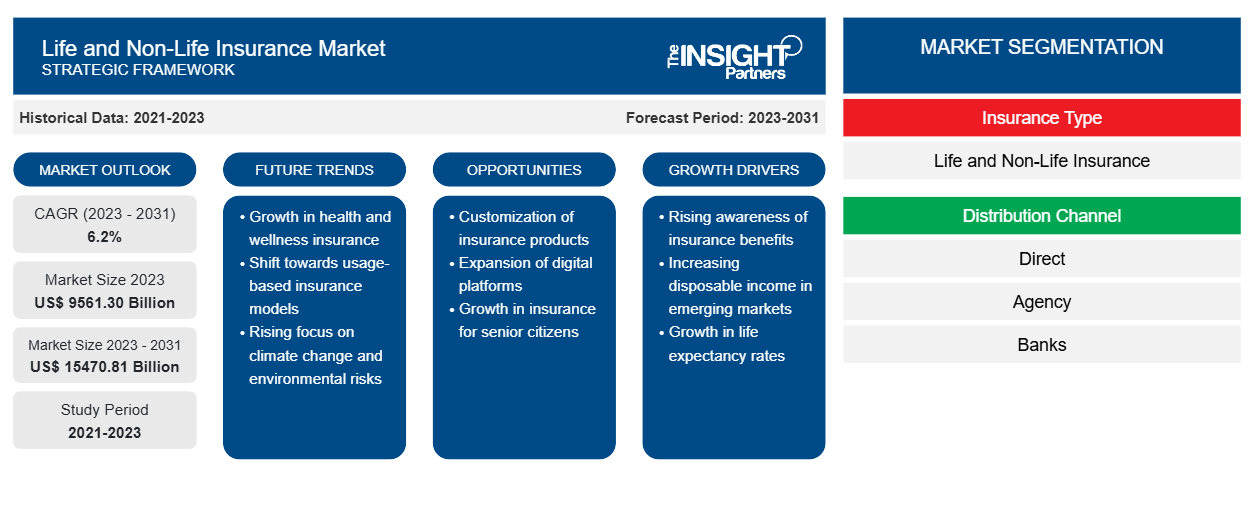人寿和非人寿保险市场规模预计将从 2023 年的 95613 亿美元增长至 到 2031 年,全球保险市场规模将达到 154708.1 亿美元;预计从 2023 年到 2031 年,全球保险市场的复合年增长率将达到 6.2%。目前,全球市场一直处于动荡之中,这可以归因于不断变化的地缘政治条件、气候变化、技术变革和客户行为。这促使全球企业重新审视公司战略,并修改其商业模式、组织文化和技术基础设施等。随着这些发展,保险行业也在不断发展,以支持企业和消费者行为发生此类变化所带来的风险。
人寿和非人寿保险市场分析
人寿和非人寿保险市场预测是根据各种二手和一手研究结果(如主要公司出版物、协会数据和数据库)估计的。经济增长、不断扩大的中产阶级、创新和监管援助正在推动保险业向前发展。全球人寿和非人寿保险市场的收入取决于发达经济体和发展中经济体的经济状况。保险业是经济的重要组成部分,因为它收取的保费数量、投资规模,更重要的是,它在承保个人和公司风险方面发挥着重要的社会和经济作用。近几十年来,全球化的发展源于跨国界商业和金融网络的扩张,使来自其他经济体的企业和工人之间的联系日益紧密。全球化程度的提高为国际投资创造了更多机会,从而产生了更多的投资挂钩计划。全球化也导致移民人数增加。将有更多的人渴望购买保险产品,为公司创造更大的前景。
定制此报告以满足您的需求
您可以免费定制任何报告,包括本报告的部分内容、国家级分析、Excel 数据包,以及为初创企业和大学提供优惠和折扣
-
获取此报告的关键市场趋势。这个免费样品将包括数据分析,从市场趋势到估计和预测。
人寿和非人寿保险
行业概览
- 由于与银行和再保险公司的合作以及与较小和较大竞争对手的合并,保险业务也开始遭受集中化进程的影响。
- 保险服务和产品的数量和种类也在不断扩大。例如,我们看到了针对新风险的保险解决方案,包括信息风险、政治风险、安全风险,甚至军事风险。
- 保险科技与金融科技一样,正在颠覆金融业务。随着保险业务拥抱技术创新和电子商务,我们预计会看到更多保险产品在线销售。
- 城市化是另一个对全球人寿和非人寿保险市场状况产生重大影响的因素。城市化需要大规模的基础设施投资、高速的工业化和不断增长的人口密度。这对风险管理和保险业具有重大影响。城市化带来社会经济发展,包括增加社会流动性、教育机会和正规就业,这将有利于人寿和非人寿保险市场的增长。
人寿和非人寿保险市场驱动因素
保险科技行业的发展推动人寿和非人寿保险市场的发展
- 保险行业正在经历一场由技术和创新保险科技解决方案推动的根本性变革。随着行业的发展,保险公司充分利用这些颠覆性技术的能力对于保持领先地位至关重要。
- 保险科技领域的远见卓识者正在开拓创新的保险技术解决方案,以满足投保人日益增长的需求,同时简化现有流程。该行业以前以传统和纸质流程而闻名,现在正以新的方式拥抱技术。例如,2024 年 2 月,位于班加罗尔的知名 IT 公司 Wipro 以 6600 万美元收购了为保险和保险科技行业提供服务的咨询和管理服务公司 Aggne。该公司旨在借此加强其财产和意外伤害保险领域的能力。此外,根据 Delloite 2023 年的一项调查,超过 86% 的 CE 保险公司认为与保险科技公司的合作可以促进他们的技术发展。这一直在推动人寿和非人寿保险市场的增长。
- 此外,人工智能和机器学习技术融入保险科技平台有望带来新的寿险和非寿险市场趋势。
人寿和非人寿保险
市场报告细分分析
- 根据保险类型,人寿和非人寿保险市场分为人寿和非人寿保险。预计非人寿保险将在 2023 年占据人寿和非人寿保险市场的很大份额。
- 非寿险通常被称为一般保险,涵盖汽车、房屋、旅行、意外等资产。健康保险是推动非寿险行业增长的细分市场。这可以归因于快速的城市化和城市劳动力可支配收入的增加。此外,在许多国家,投资健康保险还可以享受税收优惠,从而推动非寿险市场的发展。
人寿和非人寿保险
按地区划分的市场分析
人寿和非人寿保险市场报告的范围主要分为五个地区 - 北美、欧洲、亚太、中东和非洲以及南美。亚太地区 (APAC) 正在经历快速增长,预计将占据人寿和非人寿保险市场的很大份额。该地区的显著经济发展、人口增长以及对风险管理和保险的日益关注促进了这一增长。亚太地区拥有许多发展中国家,如印度和中国,推动了市场的增长。
人寿和非人寿保险
人寿和非人寿保险市场区域洞察
Insight Partners 的分析师已详尽解释了预测期内影响人寿和非人寿保险市场的区域趋势和因素。本节还讨论了北美、欧洲、亚太地区、中东和非洲以及南美和中美洲的人寿和非人寿保险市场细分和地理位置。

- 获取人寿和非人寿保险市场的区域特定数据
人寿和非人寿保险市场报告范围
| 报告属性 | 细节 |
|---|---|
| 2023 年的市场规模 | 95613亿美元 |
| 2031 年市场规模 | 154708.1亿美元 |
| 全球复合年增长率(2023 - 2031) | 6.2% |
| 史料 | 2021-2023 |
| 预测期 | 2023-2031 |
| 涵盖的领域 |
按保险类型
|
| 覆盖地区和国家 |
北美
|
| 市场领导者和主要公司简介 |
|
人寿和非人寿保险市场参与者密度:了解其对业务动态的影响
人寿和非人寿保险市场正在快速增长,这得益于最终用户需求的不断增长,这些需求源于消费者偏好的不断变化、技术进步以及对产品优势的认识不断提高等因素。随着需求的增加,企业正在扩大其产品范围,进行创新以满足消费者需求,并利用新兴趋势,从而进一步推动市场增长。
市场参与者密度是指在特定市场或行业内运营的企业或公司的分布情况。它表明在给定市场空间中,相对于其规模或总市场价值,有多少竞争对手(市场参与者)存在。
在人寿和非人寿保险市场运营的主要公司有:
- 安联
- 平安保险
- 安盛
- 中国人寿
- 大都会人寿
免责声明:上面列出的公司没有按照任何特定顺序排列。

- 了解人寿和非人寿保险市场的主要参与者概况
“寿险及非寿险市场分析”根据保险类型、分销渠道和地理位置进行调查。就保险类型而言,市场分为人寿保险和非人寿保险。根据分销渠道,人寿保险和非人寿保险市场分为直接、代理、银行和其他分销渠道。根据地理位置,市场分为北美、欧洲、亚太地区、中东和非洲以及南美。
人寿和非人寿保险
市场新闻和最新动态
公司在人寿和非人寿保险市场采用无机和有机战略,例如并购。以下列出了一些近期的关键市场发展:
- 2024 年 1 月,意大利最大的保险公司忠利集团宣布,将以约 9900 万欧元(1.08 亿美元)收购当地合作伙伴中油资本的股份,全面控制中国一家非寿险合资企业。忠利集团宣布计划扩大其在中国的分销网络,重点关注绿色商业保险,以利用中国到 2060 年实现碳中和的目标。在收购忠利中国保险 (GCI) 51% 的股份之前,中油资本于 11 月宣布将公开出售其与这家意大利保险公司合作所持有的股份。忠利集团表示,这是外国保险公司首次通过公开拍卖从一家国有企业手中收购中国财产保险公司的控股权。
[来源:Assicurazioni Generali SpA,公司网站]
- 2022 年 10 月,伯克希尔哈撒韦公司 (Berkshire Hathaway Inc.) 和 Alleghany Corporation 宣布伯克希尔哈撒韦公司完成对 Alleghany 的收购。截至交易结束前,Alleghany 普通股持有人有权获得每股 848.02 美元的现金,相当于总股权价值约 116 亿美元。交易结束后,Alleghany 成为伯克希尔哈撒韦公司的全资子公司。Alleghany 继续由 Joe Brandon 领导。高盛公司 (Goldman Sachs & Co. LLC) 担任 Alleghany 的财务顾问,Willkie Farr & Gallagher LLP 担任 Alleghany 的法律顾问。Munger, Tolles & Olson LLP 担任伯克希尔哈撒韦公司的法律顾问。
[来源:伯克希尔哈撒韦公司,公司网站]
人寿和非人寿保险
市场报告范围及交付成果
市场报告《人寿和非人寿保险市场规模和预测(2021-2031)》对市场进行了详细分析,涵盖以下领域:
- 范围内涵盖的所有主要细分市场的全球、区域和国家层面的市场规模和预测。
- 市场动态,例如驱动因素、限制因素和关键机遇。
- 未来的主要趋势。
- 详细的 PEST 和 SWOT 分析
- 全球和区域市场分析涵盖主要市场趋势、主要参与者、法规和最新的市场发展。
- 行业格局和竞争分析包括市场集中度、热图分析、关键参与者和最新发展。
- 详细的公司简介。
- 历史分析(2 年)、基准年、预测(7 年)及复合年增长率
- PEST和SWOT分析
- 市场规模、价值/数量 - 全球、区域、国家
- 行业和竞争格局
- Excel 数据集
近期报告
相关报告
客户评价
购买理由
- 明智的决策
- 了解市场动态
- 竞争分析
- 客户洞察
- 市场预测
- 风险规避
- 战略规划
- 投资论证
- 识别新兴市场
- 优化营销策略
- 提升运营效率
- 顺应监管趋势























 获取免费样品 - 人寿和非人寿保险市场
获取免费样品 - 人寿和非人寿保险市场